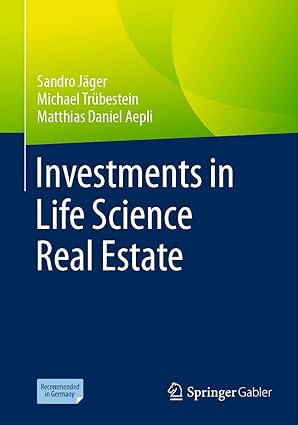
Investments in Life Science Real Estate
by: Sandro Jäger (Author),Michael Trübestein(Author),Matthias Daniel Aepli(Author)&0more
Publisher: Springer Gabler
Publication Date: 2024/7/26
Language: English
Print Length: 227 pages
ISBN-10: 3658430540
ISBN-13: 9783658430542
Book Description
The book empirically analyzes the market, drivers, trends, and building characteristics of life sciences real estate. The findings suggest significant growth potential, supported by strong market fundamentals and demographics. Investors are drawn to the sector's potential for risk-adjusted returns, capital and rental growth, and defensive characteristics. Nevertheless, the high specifications and complexity of laboratories present challenges, including high capital expenditures, maintenance costs, and the need for specialized expertise and networks. The trend towards flexible and modular laboratories and the conversion of traditional assets into lab spaces offer exciting opportunities for investments in life sciences real estate. Life sciences real estate has gained attention from investors seeking alternative options to traditional real estate sectors. This niche market has seen increased capital inflows and investor interest due to attractive returns and risk diversification. The industry encompasses various specialized subdisciplines, each with unique building and space requirements. However, the complexity and diversity of the sector pose challenges for investors in evaluating advantages, disadvantages, and risks.This textbook has been recommended and developed for universitary courses in Germany, Austria and Switzerland.
About the Author
The book empirically analyzes the market, drivers, trends, and building characteristics of life sciences real estate. The findings suggest significant growth potential, supported by strong market fundamentals and demographics. Investors are drawn to the sector's potential for risk-adjusted returns, capital and rental growth, and defensive characteristics. Nevertheless, the high specifications and complexity of laboratories present challenges, including high capital expenditures, maintenance costs, and the need for specialized expertise and networks. The trend towards flexible and modular laboratories and the conversion of traditional assets into lab spaces offer exciting opportunities for investments in life sciences real estate. Life sciences real estate has gained attention from investors seeking alternative options to traditional real estate sectors. This niche market has seen increased capital inflows and investor interest due to attractive returns and risk diversification. The industry encompasses various specialized subdisciplines, each with unique building and space requirements. However, the complexity and diversity of the sector pose challenges for investors in evaluating advantages, disadvantages, and risks.This textbook has been recommended and developed for universitary courses in Germany, Austria and Switzerland.
未经允许不得转载:电子书百科大全 » Investments in Life Science Real Estate


评论前必须登录!
登陆 注册